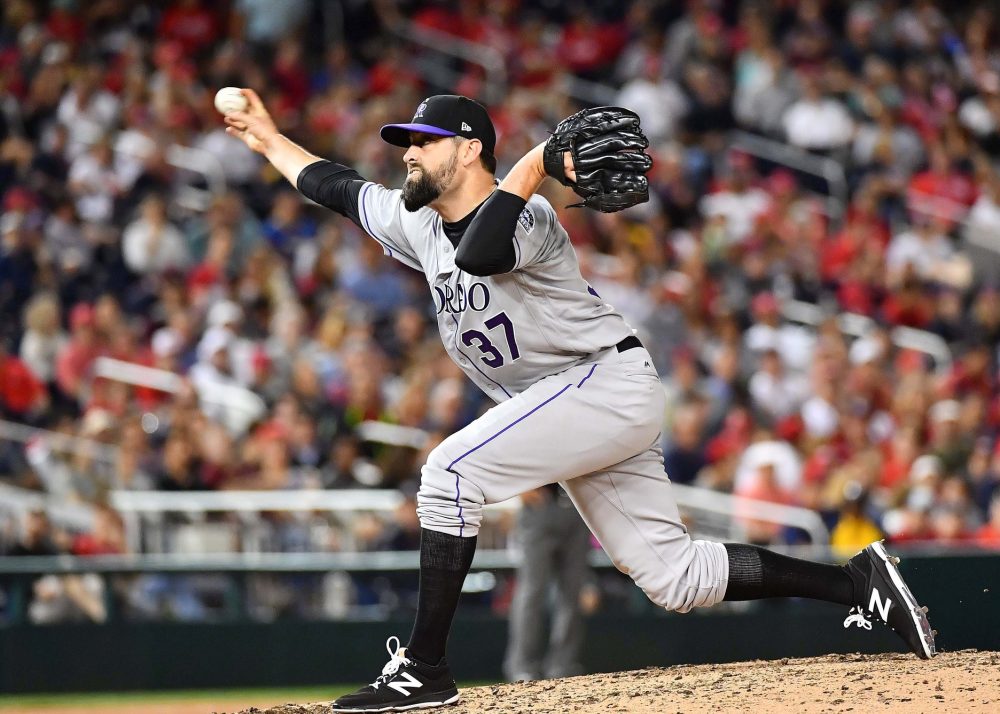
Philadelphia Phillies signed RHP Pat Neshek to a two-year, $16.25 million contract. [12/11]
Question: How does a journeyman reliever whose sinker doesn’t sink enjoy his best season at age 36, during a year in which home runs flew out of MLB parks at a record rate and while spending half of that year calling Coors Field home?
Answer: By peppering the edges of the strike zone better than ever, and better than anyone else in baseball.
Pat Neshek has never overwhelmed anyone with his velocity. He has mostly gotten outs (when he’s gotten them; there have been long stretches of relative ineffectiveness and, especially, of injury trouble) by filling up the strike zone, and by fooling people with his dipping, short-armed, high-riding delivery. He’s a sinker-slider guy, using a changeup only as an occasional setup pitch, and at times he’s toyed with positively historic levels of slider usage.
For a guy with that profile, though, he’s always done a great job of being around the strike zone.
| Season | Called Strike Probability (Rank) |
| 2013 | 50.9 (#33 of 369) |
| 2014 | 57.1 (#2 of 332) |
| 2015 | 54.8 (#5 of 329) |
| 2016 | 54.0 (#2 of 354) |
| 2017 | 55.6 (#1 of 355) |
However, with extreme fly-ball tendencies and underwhelming velocity, that control wasn’t enough to make Neshek consistently excellent. He posted pretty good ERAs in most seasons, but tools that better evaluate pitchers’ true talent—like DRA, cFIP, and WPA—tell us Neshek was often close to replacement level. He just didn’t miss enough bats to stay out of the trouble that comes with all of those fly balls.
That changed in 2017. Neshek had fanned 22 percent of opposing batters from 2010 through 2016, but in 2017 he whiffed 29.4 percent of them. He got swings and misses on 14.8 percent of his pitches, easily the highest rate of his career. When batters did put the bat on the ball, they also had a higher average launch angle than in either 2015 or 2016—but with more pop-ups, and fewer hard-hit fly balls.
He did that, quite simply, by hitting his spots much better. We use Called Strikes Above Average as a very loose proxy for a pitcher’s command ability. The more extra strikes he’s getting on the edges of the zone, the more likely it is that he’s hitting his catchers’ mitts consistently, executing well, and (therefore) frustrating hitters.
Here are Neshek’s CSAA figures for the last five seasons.
| Season | CSAA |
| 2013 | -0.24 % |
| 2014 | +0.62 % |
| 2015 | +0.61 % |
| 2016 | -0.78 % |
| 2017 | +2.48 % |
That 2017 figure is off the charts. It was the ninth-best (and third-best among relievers) of the 355 pitchers who topped 50 innings. In Neshek’s case, it’s not an abstraction, either. As much as he fills up the zone, getting those calls on the edges means that hitters find themselves perpetually fighting an uphill battle. Neshek threw roughly 49 percent of all his pitches from ahead in the count. The only pitcher who pitched nearly as much as Neshek did and was ahead in the count for that large a share of their offerings was Kenley Jansen.
When you’re around the zone this much and hitting the corners of it this reliably, opponents have to be more willing to swing. Thus, they’re more likely to swing and miss. They have to swing more defensively, so they’re less likely to drive the ball. Neshek, the longtime pelter of the zone, found in 2017 the value of being more fine. There’s no guarantee that he’ll be able to repeat all of that in 2018, but it certainly bodes well that he continued to thrive even after being dealt to Colorado. And if you’re going to bet on a 37-year-old reliever, it’s wisest to bet on one who has made concrete strides toward mastering an old-pitcher skill.
The Phillies have more money to spend than people who want to take that money, and besides, they’re holding certain spots open for one last, crucial season of evaluating some young talent. Neshek is a low-risk, high-reward move, because he could really be one of those late-30s renaissance relievers, the kind who find just the right balance of deception, stuff, and command to become unhittable for a few years. If he does, he’ll either be a key setup man when the Phillies contend again in 2019 and 2020, or a terrific trade chip. If he doesn’t, all that’s lost is money the team had no better way to spend.
Thank you for reading
This is a free article. If you enjoyed it, consider subscribing to Baseball Prospectus. Subscriptions support ongoing public baseball research and analysis in an increasingly proprietary environment.
Subscribe now